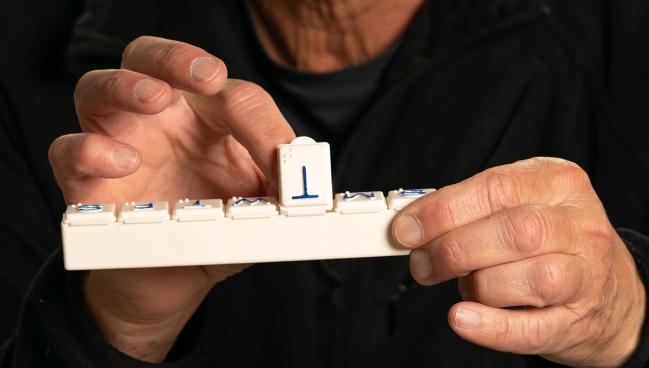Nuisance Bleeds on DAPT Not Just an Annoyance: TALOS-AMI Analysis
Having a BARC 1 bleed ups the risk of more-severe bleeding down the road, and de-escalation can be a safe option for some.

Patients with acute MI who experience nuisance bleeds in the first month post-PCI after going on ticagrelor-based dual antiplatelet therapy (DAPT) are more apt to then have more-severe bleeding events at a later date, a subanalysis of the TALOS-AMI trial shows.
But de-escalating DAPT by switching to clopidogrel at the 1-month mark appears—for both patients with nuisance bleeding and those without—to decrease the risk of subsequent bleeding without upping the odds of MACE.
Nuisance bleeding is known to have “a negative impact on the quality of life and may increase the need for rehospitalization and the rate of DAPT discontinuation,” Eun Ho Choo, MD (Seoul St. Mary’s Hospital, The Catholic University of Korea), and colleagues write in their paper, published recently in Circulation: Cardiovascular Interventions.
These bleeds, though they don’t require immediate medical attention, can indicate a patient’s future risk of more-severe bleeding and thus influence DAPT decision-making, they note. However, these concerns have not yet been well studied.
Wayne Batchelor, MD (Inova Heart and Vascular Institute, Falls Church, VA), commenting on the study for TCTMD, said that it adds to the literature by taking a “deeper dive” into the topic by clarifying who’s experiencing these bleeds and how they respond to de-escalated DAPT.
“Historically, we’ve tended to tell patients to sort of ‘suck it up’ so to speak and just live with bruising, gum bleeding, extensive bleeding after shaving. And as long as it doesn’t drop their hemoglobin or require any medical attention, we’ve tended to sweep it under the carpet,” he observed.
These results confirm that BARC 1 bleeds, even if they appear mild, may inspire later consequences, said Batchelor. They also are in line with the 2021 US revascularization guidelines, which give some flexibility to consider shorter DAPT, and are “consistent with this wave of data that’s come out from multiple other trials that are evaluating the merits of de-escalation, including TWILIGHT, STOPDAPT-2, and HOST-REDUCE-Polytech-ACS,” he noted.
Yet, Batchelor cautioned, decisions must be individualized and de-escalation may not be a good fit for everyone—patients in TALOS-AMI overall were young and at low bleeding risk.
Most Often ‘Easy Bruising’
The main TALOS-AMI trial, based in Korea, showed a net clinical benefit to DAPT de-escalation post-PCI. It involved a 1-month regimen of ticagrelor and aspirin, after which patients were randomized to remain on that combination or switch to clopidogrel and aspirin.
For this study, Choo et al excluded TALOS-AMI participants who didn’t answer the bleeding questionnaire at the time of randomization or had BARC 2 or 3 bleeding within their first month on ticagrelor. This left 2,583 patients, with a mean age of slightly less than 60 years, available for analysis.
During that initial month on ticagrelor-based DAPT after their acute MI, 416 of the patients (16.7%) had BARC 1 nuisance bleeding, most often easy bruising. Less-common types included “easy bleeding from minor cuts or shaving, nose bleeding, gum bleeding, and other local self-limited bleedings.”
The nuisance-bleeding patients were more likely to have undergone transfemoral PCI and tended to be younger and female and to have a history of diabetes. They had worse renal function, lower LVEF, and a lower PRECISE-DAPT SCORE, indicating a lower risk of bleeding. They also tended to be less adherent to ticagrelor therapy.
Patients who had these BARC 1 bleeds initially saw an increased risk of BARC 2, 3, or 5 bleeding at 6 months (HR 1.94; 95% CI 1.08-3.48). However, this risk diminished over time, such that by 1 year, nuisance bleeding within that first month no longer carried an excess risk of BARC 2, 3, or 5 bleeding (HR 1.29; 95% CI 0.70-2.14). Nor was there a difference in 1-year MACE risk (HR 1.72; 95% CI 0.87-3.39).
De-escalation from ticagrelor- to clopidogrel-based DAPT at 1 month was associated with lower risk of subsequent BARC 2, 3, or 5 bleeding both in the patients who’d had nuisance bleeds (HR 0.31; 95% CI 0.10-0.92) and in those who had not (HR 0.58; 95% CI 0.37-0.90). Neither group saw an increase in MACE with the shift to clopidogrel.
Historically we’ve tended to tell patients to sort of ‘suck it up’ so to speak and just live with bruising, gum bleeding, extensive bleeding after shaving. Wayne Batchelor
“Reducing clinically relevant bleeding by de-escalation can reduce unnecessary hospital care and healthcare costs,” while enhancing quality of life, the investigators conclude.
“However, DAPT with ticagrelor may be necessary for high-ischemic-risk patients with AMI. For those patients, physicians can explain to patients that nuisance bleeding is not associated with major bleeding; so they can safely keep DAPT with ticagrelor,” they suggest. “For the patient [at high ischemic risk] with nuisance bleeding, positive-attitude counseling on DAPT compliance through drug knowledge and understanding can minimize the impact on the quality of life and DAPT discontinuation.”
Batchelor pointed out that one question regarding the TALOS-AMI findings is their generalizability—the East Asian population as a whole tends to have a higher prevalence of the CYP2C19 loss-of-function allele. If anything, though, this would be expected to reduce the efficacy of clopidogrel, he said. It may be that the first month of more-potent ticagrelor before de-escalation made a difference.
“What we didn’t see was any hint of an increased risk of ischemic events. The problem is the study is not adequately powered in a post hoc analysis to address [the safety of de-escalation],” Batchelor added. “But at least we weren’t seeing a major signal there.”
Caitlin E. Cox is News Editor of TCTMD and Associate Director, Editorial Content at the Cardiovascular Research Foundation. She produces the…
Read Full BioSources
Choo EH, Choi IJ, Lim S, et al. Prognosis and the effect of de-escalation of antiplatelet therapy after nuisance bleeding in patients with myocardial infarction. Circ Cardiovasc Interv. 2022;15:e012157.
Disclosures
- This study was supported by ChongKunDang Pharm, Medtronic, Abbott, and Boston Scientific.
- Choo and Batchelor report no relevant conflicts of interest.





Comments